Aihole
Aihole, once a mercantile metropolis with a flourishing Jaina community, but today little more than a hamlet, is well worth a visit though it is not a Jaina tirtha (holy place of pilgrimage) in the true sense of the word.
None of the about a dozen Jaina sacred buildings is in active worship. Some of them have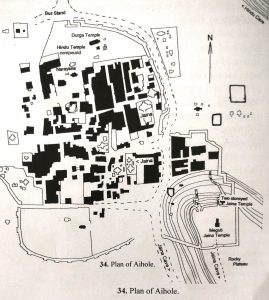 been converted into Hindu shrines while others were used until recent times by local farmers as stables for cattle and as human dwellings Among the inhabitants of Aihole there are at present no Jaina families.
been converted into Hindu shrines while others were used until recent times by local farmers as stables for cattle and as human dwellings Among the inhabitants of Aihole there are at present no Jaina families.
But “only here, writes J.C. Harle in his 1986 Pelican History of Indian Art and Architecture (p. 166), is it possible to see side by side, and already fully developed, temples of the northern Nagara type and others in the Dravida mode of South India.”
This applies to both Hindu and Jaina shrines, the oldest of which date back to the sixth/seventh century.
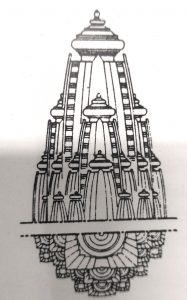
Ahola has a small museum, a tourist bungalow but no dharmashala (lockable rooms for pilgrims). The buses to and from Badami halt at Pattadakal (see ill.39)
Nagara type temple tower (Shikhara), developed in north India. The sketch follows the lines of the Parshvanatha Temple at Khajuraho,970. For the Dravida mode see ill. 39
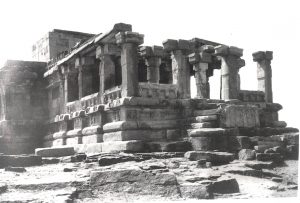 Aihole. Meguti Jaina Temple, prominently placed on top of the highest hill of the village, was built in 634, as recorded in the famous Sanskrit verse-inscription embedded in the eastern outer wall (note the black plaque in the photo above).
Aihole. Meguti Jaina Temple, prominently placed on top of the highest hill of the village, was built in 634, as recorded in the famous Sanskrit verse-inscription embedded in the eastern outer wall (note the black plaque in the photo above).
Only two of the original sculptures have survived: a large, seated Mahavira and a partly mutilated but still convincingly beautiful goddess Ambika.
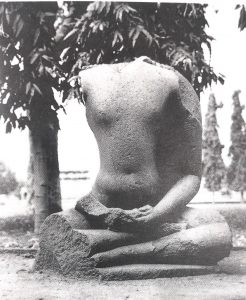
Torso of a perfectly proportioned Jina. The tresses of locks on the shoul- ders indicate that it was a representation of Adinatha. Aihole Museum.
Details from ceiling in the Mena basti Jaina Cave at Aihole showing (above) an amorous couple (mithuna) and (Jeff) the motif of the disgorging warrior Timingila. The dis- gorged figure of a human symbolizes the coming and going of time. Seventh century
(opposite), Pattadakal Disused Jaina Temple, 1.6 km to the north-west of the village. An outstanding monument built in Dravida style. Eighth ninth century.
outstanding monument built in Dravida style. Eighth ninth century.
The pillars “though of sandstone, are partially “lathe-turned, unticipating the more completely lathe-turned pillars of schist and soapstone seen at Halebid and other places (K.R. Srinivasan in Jaina Art and Architecture, Vol. 1: 201).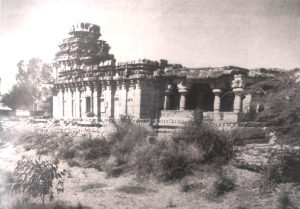

The standing Jina found in this temple has been removed to the local museum situated near the Hindu temple-enclave.
